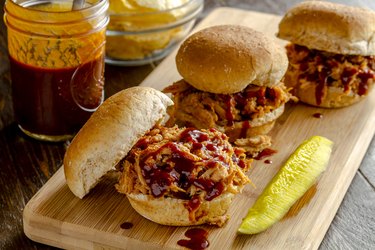
Pulled pork is typically a barbecue dish made with pork shoulder, also known as pork butt or Boston butt, over the course of 18 to 36 hours at minimal heat. The low- and slow-cooking method is required to break down the pork shoulder's tough consistency and to tenderize and flavor the meat. If you are short on time, making a few changes to the recipe allows you to speed the process of cooking pulled pork to about one hour.
Different Cut of Pork
Video of the Day
The most important part of speeding up the pulled pork cooking process is selecting a different cut of meat. Speeding the process of cooking pulled pork with a traditional pork shoulder results in a tough and chewy meal. Pork tenderloin cooks in a fraction of the time and absorbs flavor just as well as Boston butt. You do not need to remove a bone from the center of the meat with pork tenderloin, speeding up the process even further. Tenderloin is low fat and makes pulled pork a healthier dish; in comparison, Boston butt has a relatively high fat content.
Video of the Day
Faster Pork Cooking Method
Rather than smoking or roasting Boston butt for several hours after a lengthy marinating process, you can fully cook pork tenderloin in less than 30 minutes. Pat a room-temperature pork tenderloin dry with paper towels and rub it with your chosen spice blend. If you do not have one, combine equal amounts of paprika, brown sugar, celery salt, onion powder, ground black pepper, dry mustard and garlic powder. Skip the celery salt if you would like to minimize sodium content. Preheat a skillet over medium heat and add 2 tablespoons of butter or olive oil. To cut fat, use 1 tablespoon of margarine instead. Brown all sides of the pork tenderloin for about two minutes each and then cover the skillet. Reduce the heat to medium-low and continue cooking the pork tenderloin for 20 minutes, flipping it once. Test the pork's internal temperature with a meat thermometer; the meat is finished cooking when it reads 145 degrees Fahrenheit. As soon as the temperature is correct, remove the tenderloin from the skillet and place it on a clean surface. Shred the pork quickly by cutting the tenderloin into 2-inch-thick slices and pulling them apart with two forks.
Preparing the Sauce
Pour 2 cups of your favorite barbecue sauce into a pot for every pork tenderloin you prepared. If you would like to mimic the flavor of pork shoulder, select a smoky variety or add a few drops of smoke extract. Set the pot over medium heat and stir in 2 tablespoons of red-wine vinegar. The vinegar enhances the barbecue sauce's flavor and tenderizes the pork. Simmer the sauce for five minutes while the tenderloin is cooking in the skillet. Blend the shredded tenderloin with the sauce and serve the pulled pork while hot. If you do not want a saucy pulled pork recipe, simmer only 1 cup of sauce for each tenderloin to absorb.
Leftovers
Do not allow the pulled pork to rest at room temperature for more than two hours. Package leftovers in an airtight container and refrigerate or freeze them as soon as possible. Use refrigerated leftovers within four days and frozen leftovers within two to three months. Always reheat leftover pulled pork to a minimum temperature of 165 degrees Fahrenheit to kill potential bacteria buildup.
Nutritional Information
Boston butt, the traditional ingredient in pulled pork, contains about 21 grams of protein and 15 grams of fat per 3-ounce serving. This is about 42 percent of your daily recommended intake, or DRI, of protein and 24 percent of your DRI of fat, based on a 2,000-calorie diet. In comparison, one 3-ounce serving of pork tenderloin contains approximately 17 grams of protein and 3 grams of fat. This is about 34 percent of your protein DRI and 5 percent of your fat DRI. Overall, the reduced fat in pork tenderloin makes it the healthier option.